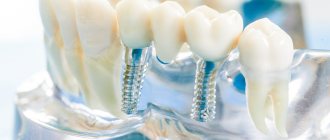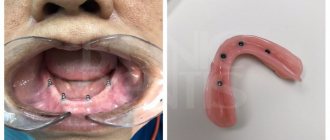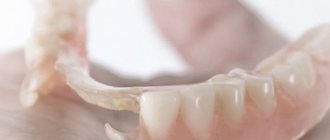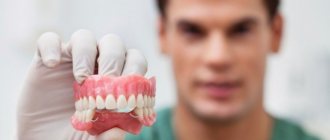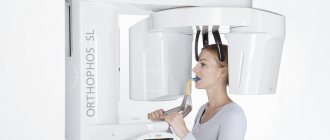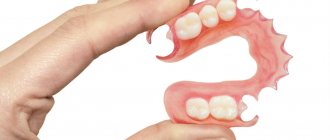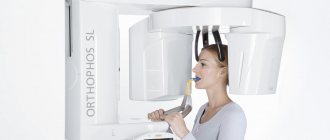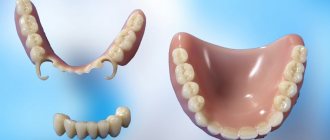The absence of teeth in the mouth is a serious problem for a person, and it needs to be solved as quickly as possible, because with a toothless jaw it is not only impossible to smile and speak openly and without embarrassment. Complete edentia entails impaired diction and does not allow high-quality chewing of food, which is fraught with the development of diseases of the digestive system of the body. To solve the problem, modern dentistry is ready to offer the patient various prosthetic options, including the installation of a conditionally removable denture on implants.
What are conditionally removable dentures on implants, what is the difference between conditionally removable and removable dentures, what benefits can a patient receive by choosing this prosthetic option? We will give a detailed answer to all these questions below.
Conditionally removable prosthesis on implants: description and features
Conditionally removable dentures are a special type of orthopedic structures used in dental prosthetics. Prostheses of this type are an alternative to traditional removable and fixed dentures.
Conditionally removable dentures on implants differ from classical fixed structures at a significantly lower cost, because for their reliable and most durable fixation in the oral cavity, a significantly smaller number of implants are required, even if the problem of a complete absence of teeth in a row has to be solved.
Conditionally removable structures on implants will differ from removable dentures in terms of higher strength, reliability of fixation and comfort in use. The possibility of using such materials as ceramics and zirconium in conditionally removable prosthetics on implants makes it possible to obtain an aesthetic result: ceramic and zirconium dentures look natural, which cannot be said about artificial teeth made of plastic. Conditionally removable structures on implants will differ from removable dentures in terms of higher strength, reliability of fixation and comfort in use.
The possibility of using such materials as ceramics and zirconium in conditionally removable prosthetics on implants makes it possible to obtain an aesthetic result: ceramic and zirconium dentures look natural, which cannot be said about artificial teeth made of plastic.
Conditionally removable dentures on implants got their name because of the peculiarities of fixation: they are attached to pre-implanted artificial roots (implants) and a person cannot remove them independently. But if necessary, their removal can be easily carried out by a specialist in a clinical setting. Conditionally removable dentures on implants will have to be removed from time to time for professional cleaning of the orthodontic structure, which will extend the useful life of the product and maintain its aesthetic appearance.
Implant attachment options
Removable structures are fixed to implants using beam and push-button fastening.
Beam fixation
Beam fastening is used on classic implants. The implanted artificial roots are connected by a metal permanent beam, which unites them and serves as part of the fastening of the orthopedic structure. The base of the prosthesis has a second part of the fastening - a recess in the shape of a beam, into which silicone holders are installed in the projection of the implants. When putting on the prosthesis, both parts of the fastening meet, the structure is securely fixed.
Due to the beam, the chewing load is evenly distributed between all implants. The quality of fastening is higher in comparison with push-button ones, but it also costs more.
Push-button type
Push-button fixation is used on classic and mini-implants with spherical or equatorial abutments.
- Ball mount.
After classic implants are implanted, spherical abutments are screwed into them, which protrude above the mucosa. Mini-implant designs already have a built-in aba. In the base of the orthopedic design, in the projection of each installed implant with an abutment, there is a recess with a metal holder for a silicone matrix and the matrix itself - a rubber sealing ring. When the product is put on, the ball-shaped abutment passes through the ring and is securely fixed with it. The disadvantage of prosthetics on spherical abutments is their wear due to friction. The heads become flat, the sealing ring no longer holds them - the abutments have to be changed or mini-implants must be reinstalled. - Equator mount on abutments
(Locator system). The principle of fixation remains the same, the shape of the abutment and the type of interaction between the head and the silicone matrix change. Constructions on equatorial abutments are easier to remove and easier to care for.
The advantage of push-button fastening is its low price. The downside is the relative instability of the product and the uneven distribution of the load on the implants.
On telescopic crowns
The essence of the method is to make a double crown. One is called primary and covers the prepared supporting implant. The secondary crown is larger, it is built into the frame of the prosthesis and covers the primary crown. The result is a reliable fixation system in the form of two crowns, which can be separated without effort and, if desired, the product can be removed.
Indications, types of structures used in conditionally removable prosthetics on implants
Conditionally removable dentures on implants are most often used in cases of complete absence of teeth in the patient, with multiple edentia. Also, conditionally removable structures on implants can be installed when, for a number of reasons, it is impossible for the patient to receive classic fixed dentures. Conditionally removable prosthetics on implants will be the optimal method for restoring lost teeth for patients who do not want to use removable dentures that are fragile and inconvenient to use.
The procedure for conditionally removable prosthetics on implants uses plate-type orthodontic products having the following structural design:
The base is artificial gum made from a polymer mass;
Crowns - artificial teeth - are placed on the plastic gum;
If a clasp prosthesis is used in conditionally removable prosthetics, then at the base of the product there will be a clasp - a strong metal arch.
Lamellar dentures can be fixed in the oral cavity without prior implantation - using special hooks that are attached to the supporting teeth. With a completely toothless jaw, this method of fixation is excluded, as is the use of clasp dentures - to ensure a stable position of the prosthesis in the mouth, supporting, living and healthy teeth are required. But both structures can be secured to implants. This will allow you to obtain high aesthetics and durability of prosthetic results.
What are the alternatives?
Removable dentures are mainly used to restore large numbers of lost teeth. Therefore, the only alternative can be only classic removable dentures: supported on living teeth (for partial edentia) or on the gums (for complete edentia). However, such prostheses are less comfortable, do not fit well, and their hooks can be noticeable. In addition, removable dentures cause bone tissue atrophy due to insufficient load, which will lead to its subsidence and the need for regular relining (adjustment) of the removable structure.
Removable dentures on implants are fairly easy to care for. An important feature is that it is necessary to clean not only the crowns, but also the gum base from the inside - in the area of fixation on the implants. To do this, the prosthesis can be removed, or you can use an irrigator - a device that, under pressure, allows you to clean hard-to-reach spaces. This is necessary in order to reduce the accumulation of plaque and bacteria on the gums, and protect the mucous membranes and tissues around the implants from inflammation.
1 Kopeikin V.N., Mirgazizov M.Z. Orthopedic dentistry, 2001.
The main stages of conditionally removable prosthetics on implants
Conditionally removable prosthetics on implants is carried out in several main stages, and below we will analyze in detail the features of each stage of treatment.
Diagnosis and treatment
During the patient’s initial visit to the dental clinic, a thorough examination of the oral cavity is required and a number of diagnostic measures are prescribed. Diagnostics is of fundamental importance: it allows us to exclude possible contraindications to conditionally removable prosthetics on implants. If during preparation for the procedure gum inflammation or other dental diseases are detected, therapeutic measures must be taken to eliminate them before prosthetics on implants.
Implantation
The procedure for implantation before installing a conditionally removable prosthesis can be carried out according to the protocol of classical or simultaneous implantation. The second option is more gentle for the patient and also allows you to significantly reduce the overall treatment time. The implants are implanted into the sockets of the extracted teeth, and almost immediately a temporary prosthesis is placed on them, which is replaced with a permanent structure within two to three weeks. However, if the teeth were lost a long time ago, and the bone tissue has lost its height and volume, it is not possible to carry out express implantation. Classical implantation is carried out in two stages, and a permanent prosthesis will be installed only after the artificial roots have completely engrafted; usually the duration of the osseointegration process of implants is several months.
Manufacturing and installation of a permanent prosthesis
After installing the implants and temporary prosthesis, impressions are taken, on the basis of which a conditionally removable prosthesis will be made. The price of a permanent prosthesis will depend on its type, material of manufacture and method of fixation. We will examine in detail the possible options for fixing conditionally removable dentures on implants in the next section of the article.
Complete removable lower jaw prosthesis
For lower jaw prosthetics, up to six artificial roots should ideally be used. But if the bone tissue allows, 2 to 4 implants (whether classic or mini-products) are permissible to fix a removable denture. This is due to the increased density and thickness of the lower jaw bone.
When implanted with titanium roots into high-quality jawbone, structures of any length and diameter have excellent primary stability.
The use of traditional implants is always preferable, but in the case of the lower jaw, the installation of mini-implants is justified for the patient.
Fixation options
Conditionally removable dentures can be fixed to implants in different ways. Two main methods for reliable connection of a prosthesis with implanted implants have been developed and are actively used - beam and spherical.
Beam fixation
The technique is recognized by experts as the most reliable and durable. Its essence lies in the fact that all implanted implants are connected to each other by a special metal beam that has recesses for fixing the prosthesis. This fixation technology provides another advantage - it allows you to reduce the number of implants. The metal beam will ensure their reliable fixation in the bone tissue and at the same time ensure uniform distribution of the load on the bone from the installed prosthesis.
Ball-shaped fixation
In this method of securing a conditionally removable denture, the implants are not connected to each other. The prosthesis itself is placed on a spherical abutment and secured with specialized miniature locks. This type of fixation of conditionally removable dentures is considered less reliable, but can reduce treatment costs - installing dentures with beam fixation on implants is more expensive.
How does the dental implantation process work?
The use of a prosthesis on an implant will allow the artificial tooth to be fully used.
Under local anesthesia (and, if the patient wishes, under general anesthesia), the doctor makes an incision in the gum in the area of the socket of the missing tooth and screws in a titanium screw . After this, a small suture is placed on the mucous membrane, and the patient is sent home.
After 3-6 months , during which the implant is “overgrown” with bone tissue and securely fixed in the jaw, an abutment is attached to it, on which a crown is placed , or another prosthetic structure (bridge, removable denture) is fixed.
Conditions necessary for prosthetics on implants and successful implantation of the implant into the bone
Like any medical intervention, the implantation procedure has its own indications and contraindications . More detailed information on this matter can be obtained at an appointment with an orthopedic doctor.
Before the operation, all teeth must be treated, as well as periodontal and soft tissue diseases, if any.
After implantation, be sure to brush your teeth at least twice a day . Careful oral hygiene eliminates the possibility of infection of the postoperative suture and promotes rapid healing of soft tissues and mucous membranes in the surgical area.
Advantages and disadvantages
Conditionally removable prosthetics on implants is a technique that allows you to obtain the following advantages when restoring lost teeth:
Comfort during use. Adaptation to the prosthesis is quick and is not accompanied by diction problems; the prosthesis does not fall out of the mouth when talking or eating;
All fastening elements are located inside the prosthetic product and are therefore completely invisible in the oral cavity;
The conditionally removable prosthesis itself has compact dimensions;
Injury to the soft tissues of the mouth is excluded;
Correction of prostheses is necessary only during the period of osseointegration of implants;
Long useful life of prostheses. Conditionally removable products last twice as long as removable structures, as they are more resistant to external factors and mechanical load;
Conditionally removable structures do not require complex and specific maintenance. They do not have to be regularly removed from the mouth and stored in a special container. From time to time you will visit the dentist, where your dentures will be professionally cleaned.
The only disadvantage of conditionally removable prosthetics is the higher cost, as well as the presence of a plastic base in the design. A base made of polymer material can cause an allergic reaction, but modern conditionally removable dentures on implants use hypoallergenic materials that do not cause irritation to sensitive mucous membranes.
Dentures for completely edentulous upper jaw
Up to 8 implants are implanted into the jawbone from above, since the bone here is loose and subject to atrophy (compared to the lower jaw). In some cases, removable prosthetics of the upper jaw are organized on 4-6 implants, if the density and size of the bone allows.
If there is a significant deficiency of bone tissue, there is a risk of injury to the maxillary sinuses, then a sinus lift is performed first or mini-implants are used.
Mini-sized artificial roots are not the best option for fixing removable dentures on the upper jaw. Titanium roots will not stick to loose fabric. If mini-products are implanted, the Locator fixing mechanism is used.
Indications and contraindications
| Indications for installation: | Contraindications: |
| missing one tooth; | acute inflammatory diseases in the oral cavity; |
| loss of several teeth on the jaw; | neuropsychiatric disorders; |
| complete edentia; | malocclusion; |
| impossibility of making a removable denture. | severe periodontitis. |
Prosthetics on implants in professorial dentistry “22nd century”
In the professorial dentistry, a whole staff of dentists works for you - therapists, orthopedists and implantologists, including professors, doctors and candidates of medical sciences.
Every patient who comes to the “22nd century” will be consulted by the head doctor of the clinic for free . During the visit, the optimal treatment and prosthetic plan will be selected.
In professorial dentistry, a whole staff of dentists works for you - therapists, orthopedists and implantologists, including professors, doctors and candidates of medical sciences. Our clinic is pleased to offer its patients not only an individual approach to solving the problem, but also affordable prices for services .
To make an appointment for a free appointment, just call one of the numbers listed in the header of the site.
Don't put off your visit to the dentist until tomorrow. Take a look into the “22nd century”, give yourself health and a beautiful white-toothed smile now!
Date of publication: September 20, 2020 Last update: September 22, 2022 © 2020 Professorial Dentistry “22 Century”. All rights reserved.
